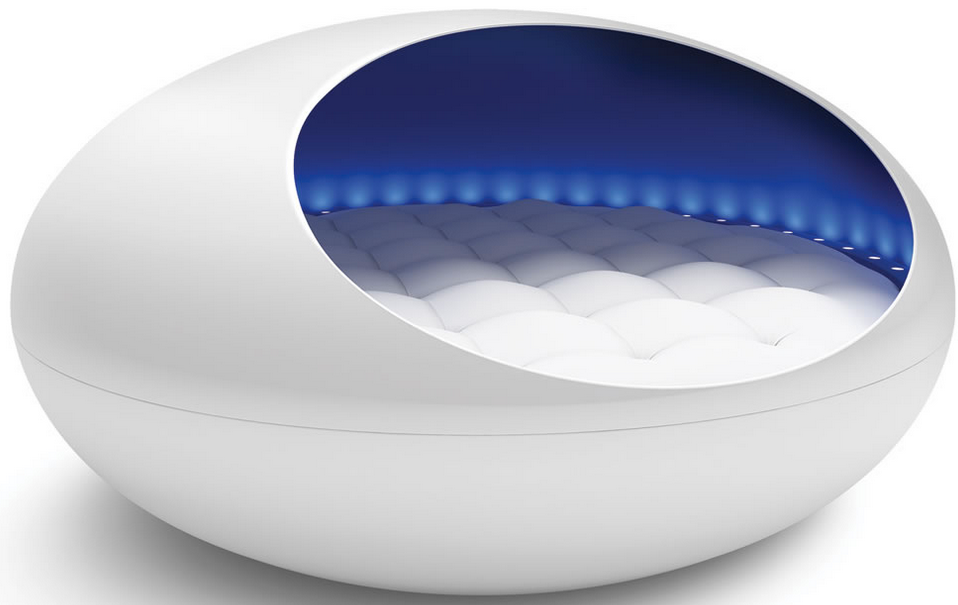Whole-body vibration may be as effective as regular exercise
March 16, 2017

Hate treadmills? No prob. The Tranquility Pod uses “pleasant sound, gentle vibration, and soothing light to transport the body, mind, and spirit to a tranquil state of relaxation” — and maybe lose weight (and $30,000). (credit: Hammacher Schlemmer)
If you’re overweight and find it challenging to exercise regularly, now there’s good news: A less strenuous form of exercise known as whole-body vibration (WBV) can mimic the muscle and bone health benefits of regular exercise — at least in mice — according to a new study published in the Endocrine Society’s journal Endocrinology.
Lack of exercise is contributing to the obesity and diabetes epidemics, according to the researchers. These disorders can also increase the risk of bone fractures. Physical activity can help to decrease this risk and reduce the negative metabolic effects of these conditions.
But the alternative, WBV, can be experienced while sitting, standing, or even lying down on a machine with a vibrating platform. When the machine vibrates, it transmits energy to your body, and your muscles contract and relax multiple times during each second.
“Our study is the first to show that whole-body vibration may be just as effective as exercise at combating some of the negative consequences of obesity and diabetes,” said the study’s first author, Meghan E. McGee-Lawrence, Ph.D., of Augusta University in Georgia. “While WBV did not fully address the defects in bone mass of the obese mice in our study, it did increase global bone formation, suggesting longer-term treatments could hold promise for preventing bone loss as well.”
Just as effective as a treadmill
Glucose and insulin tolerance testing revealed that the genetically obese and diabetic mice showed similar metabolic benefits from both WBV and exercising on a treadmill. Obese mice gained less weight after exercise or WBV than obese mice in the sedentary group, although they remained heavier than normal mice. Exercise and WBV also enhanced muscle mass and insulin sensitivity in the genetically obese mice.
The findings suggest that WBV may be a useful supplemental therapy to combat metabolic dysfunction in individuals with morbid obesity. “These results are encouraging,” McGee-Lawrence said. “However, because our study was conducted in mice, this idea needs to be rigorously tested in humans to see if the results would be applicable to people.”
The authors included researchers at the National Institute of Health’s National Institute of Aging (NIA). Funding was provided by the American Diabetes Association, the National Institutes of Health’s National Institute of Diabetes and Digestive Kidney Diseases, and the National Institute on Aging.
Know a cheaper alternative to the Tranquility Pod? Sound off below!
* To conduct the study, researchers examined two groups of 5-week-old male mice. One group consisted of normal mice, while the other group was genetically unresponsive to the hormone leptin, which promotes feelings of fullness after eating. Mice from each group were assigned to sedentary, WBV or treadmill exercise conditions.
After a week-long period to grow used to the exercise equipment, the groups of mice began a 12-week exercise program. The mice in the WBV group underwent 20 minutes of WBV at a frequency of 32 Hz with 0.5g acceleration each day. Mice in the treadmill group walked for 45 minutes daily at a slight incline. For comparison, the third group did not exercise. Mice were weighed weekly during the study.
Abstract of Whole-body vibration mimics the metabolic effects of exercise in male leptin receptor deficient mice
Whole-body vibration has gained attention as a potential exercise mimetic, but direct comparisons with the metabolic effects of exercise are scarce. To determine whether whole-body vibration recapitulates the metabolic and osteogenic effects of physical activity, we exposed male wildtype (Wt) and leptin receptor deficient (db/db) mice to daily treadmill exercise or whole-body vibration for three months. Body weights were analyzed and compared with Wt and db/db mice that remained sedentary. Glucose and insulin tolerance testing revealed comparable attenuation of hyperglycemia and insulin resistance in db/db mice following treadmill exercise or whole-body vibration. Both interventions reduced body weight in db/db mice and normalized muscle fiber diameter. Treadmill exercise and whole-body vibration also attenuated adipocyte hypertrophy in visceral adipose tissue and reduced hepatic lipid content in db/db mice. Although the effects of leptin receptor deficiency on cortical bone structure were not eliminated by either intervention, exercise and whole-body vibration increased circulating levels of osteocalcin in db/db mice. In the context of increased serum osteocalcin, the modest effects of TE and WBV on bone geometry, mineralization, and biomechanics may reflect subtle increases in osteoblast activity in multiple areas of the skeleton. Taken together, these observations indicate that whole-body vibration recapitulates the effects of exercise on metabolism in type 2 diabetes.